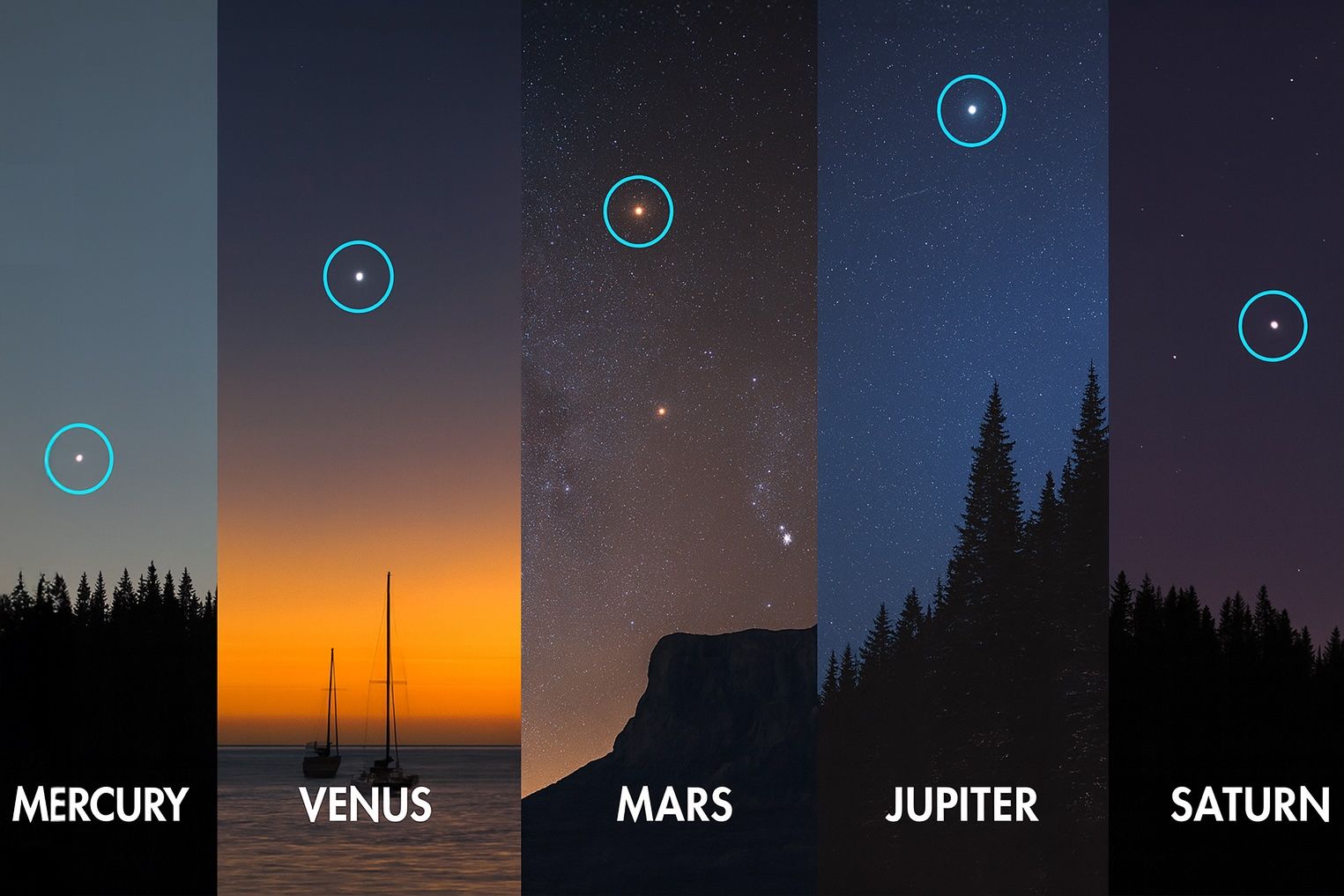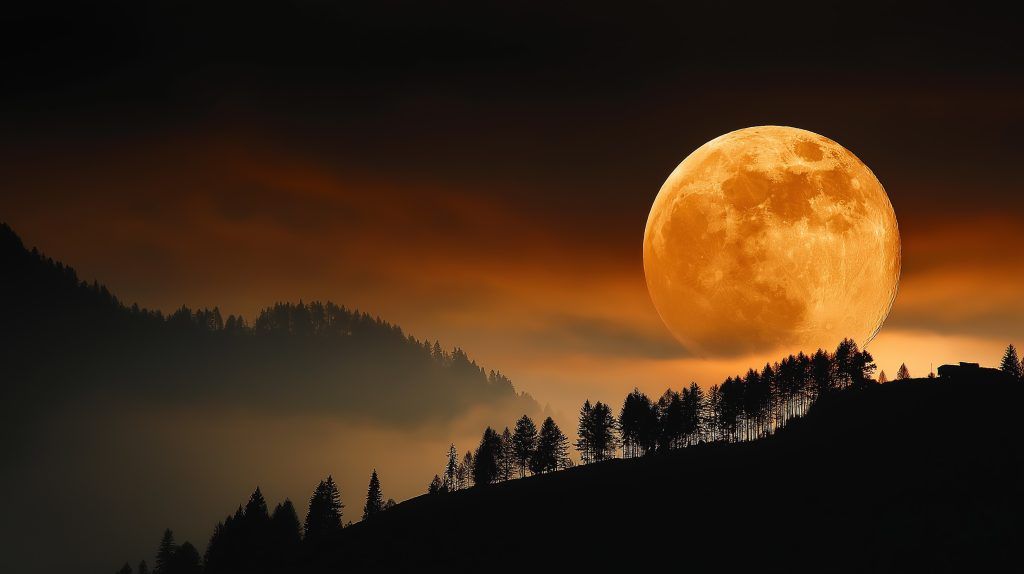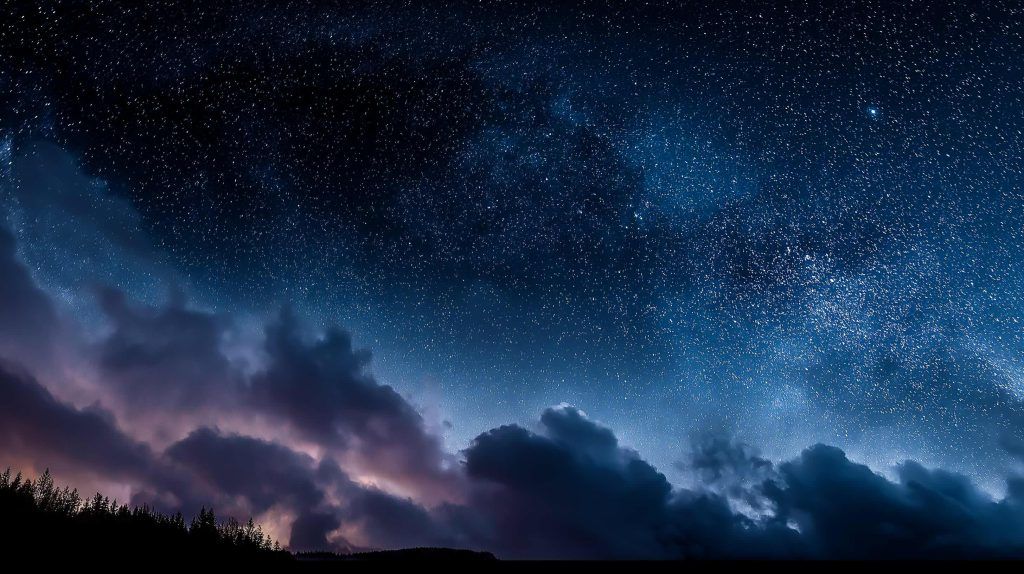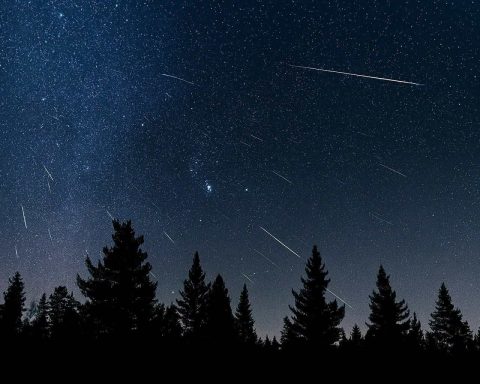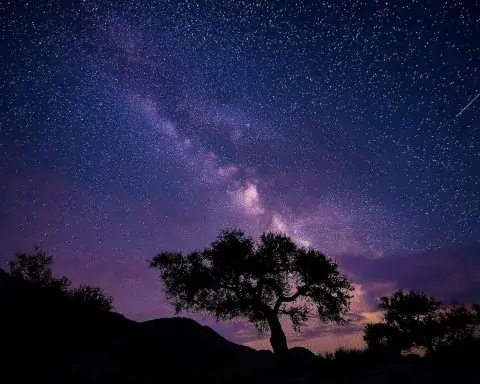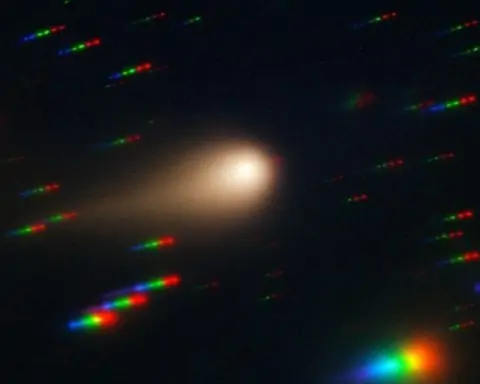- On August 10, six planets—Mercury, Venus, Jupiter, Saturn, Uranus, and Neptune—will line up in a broad arc in the pre-dawn sky.
- Four of these planets (Mercury, Venus, Jupiter, Saturn) are visible to the naked eye, while Uranus and Neptune require binoculars or a small telescope.
- NASA notes that planetary parades of this kind occur only every few years, and become rarer as more planets join the lineup.
- The best viewing period is in mid-to-late August, with the prime nights around August 23 when the Moon is near new and does not wash out the view.
- Venus and Jupiter come very close on the mornings of August 11 and 12, appearing less than a degree apart.
- Mercury reaches its greatest western elongation around August 19, offering about a 90-minute pre-sunrise view during August 18–23.
- In mid-northern latitudes, the pre-dawn arrangement on August 10 places Neptune and Saturn toward the southwest around 40°, Uranus toward the southeast around 55°, and Venus and Jupiter low in the east at about 20°.
- Uranus will be magnitude about 5.7 and located near the Pleiades in Taurus, best seen with binoculars or a telescope.
- Neptune will be magnitude about 7.8 and appears as a tiny blue-green point near Saturn, becoming more accessible later in August with binoculars or a telescope.
- The next opportunity to see six or more planets aligned at once isn’t until late February 2026, making this August event a now-or-not-for-several-years spectacle.
A Dawn Spectacle After the Sturgeon Moon
Skywatchers are in for a celestial treat this August. On the heels of the Sturgeon Moon (the full moon of August, peaking on Aug. 9), an extraordinary multi-planet display will grace the pre-dawn sky [1]. Beginning August 10, six planets – Mercury, Venus, Jupiter, Saturn, Uranus, and Neptune – will line up in a broad arc across the early morning sky [2] [3]. Four of these worlds (Mercury, Venus, Jupiter, and Saturn) shine bright enough to see with the naked eye, while distant Uranus and Neptune require binoculars or a small telescope [4]. According to NASA, such “planet parades” only happen every few years, and the more planets involved, the rarer the event [5]. In other words, this is a must-see cosmic phenomenon – astronomers urge you not to miss this chance to glimpse six planets at once in our sky [6]!
When and Where to See the Planetary Alignment
Mark your calendar from August 10 through late August. During this period, all six planets will be visible in the hour or so before sunrise each clear morning [7]. The lineup kicks off around August 10, when Mercury first pops above the horizon to join the others, and continues until the final days of the month (by which time Mercury will sink too close to the Sun to be seen) [8]. For the best viewing, plan to head outside about 45 minutes to an hour before your local sunrise – early enough that the sky is still dark, but late enough that all planets have risen above the horizon [9]. Face generally east and scan from the horizon upward and toward the south; the planets will span a long arc roughly along the ecliptic (the Sun’s apparent path) across the eastern half of the sky [10].
Location matters: try to find a spot with an unobstructed view of the low eastern sky (no trees or buildings blocking the horizon) [11] [12]. In mid-northern latitudes, the pre-dawn configuration on August 10 will have Neptune and Saturn positioned toward the southwest (~40° above the horizon), Uranus higher toward the southeast (~55° up), and brilliant Venus and Jupiter low in the east (about 20° above the horizon) [13]. Mercury, always the most elusive, will barely clear the eastern horizon by the start of dawn on those dates [14]. If you’re observing from the Southern Hemisphere, look toward the northern half of the sky instead – the six planets will still form a broad arc, but appear slightly lower and shifted northward compared to the Northern Hemisphere view [15]. In either case, all six will be spread out across much of the sky, not clustered in a single tight group, so give yourself a wide viewing perspective.
Why Late August Offers the Best View
While the planetary parade begins on August 10, veteran skywatchers advise patience – the prime time to catch it will be around the third week of August. Here’s why: Moonlight can interfere with faint objects, and early in the month the waning gibbous moon’s glare will make spotting dim Neptune very challenging [16]. (In fact, August 10 is just one day after a full moon, so the sky will be awash with moonlight.) By contrast, around August 23 the moon will be near its new moon phase, meaning little to no moonlight to wash out the view [17]. This dark-sky window comes right as Mercury reaches its greatest western elongation (furthest apparent distance from the Sun) on August 19, which gives Mercury a longer pre-sunrise appearance [18]. During the August 18–23 period, Mercury rises earlier and climbs higher each day, creating about a 90-minute gap between Mercury-rise and sunrise at peak – the longest and best chance to spot tiny Mercury before dawn’s light [19]. In short, the week of the new moon in late August provides ideal conditions: dark skies and all six planets accessible in the hours before sunrise. “The best date to view these planets is on the nights leading up to August 23, when there will be little to no moonlight” reducing visibility [20], according to Wired. So if you can time your outing, plan for those moon-free mornings in mid/late August to maximize your planetary haul.
Meet the Planets: How to Spot All Six
Each planet in this parade has its own character. Here’s what to look for and where:
- Mercury: Elusive and low. Mercury is the faintest of the four naked-eye planets and hugs the horizon very closely. In mid-August it rises between about 4:30 and 5:30 a.m. local time for mid-northern observers (later, around 6:30 a.m., if you are far south) [21]. Look very low in the east during the 30-45 minutes before sunrise – Mercury will appear as a modest twinkle that never gets far above the horizon. Your best chance comes between Aug. 18 and 23, when Mercury is highest in the dawn sky (about 10° elevation at peak) due to its elongation [22]. Even then, it remains a challenge; you’ll need a flat, clear view to the east and transparent skies. Important: do not use binoculars or telescopes once the sky has begun to brighten near sunrise – accidentally pointing optics at the Sun can cause serious eye damage [23]. As a rule of thumb, stop trying to observe Mercury once the Sun is close to rising.
- Venus: The dazzling “Morning Star.” Venus is by far the brightest planet of the bunch, outshining even Jupiter. It rises around 2:30–3:30 a.m. local time (north of the equator) and climbs to about 20–30° above the eastern horizon by sunrise [24] [25]. You can’t miss Venus – it gleams with a steady silvery-white light (magnitude ≈ –4.0) and is often the first “star” you’ll notice in the east before dawn. In fact, Venus and Jupiter make a spectacular close approach in mid-August: on the mornings of August 11 and 12, these two brightest planets will appear extremely close together in the sky, less than a degree apart (about the width of your finger at arm’s length) [26]. During this conjunction, they may look like a brilliant double planet – a real highlight of the month. Venus will then slowly drift lower each day, but remains a beacon in the east throughout August. If you have a small telescope, you can even observe Venus’s phase (it shows phases like the Moon does) appearing as a tiny crescent in August [27].
- Jupiter: King of planets, rising with Venus. Jupiter, the largest planet, is the second-brightest object in this lineup (magnitude ≈ –1.9) and sits near Venus each morning before sunrise [28]. It rises roughly around the same time as Venus and will be just to the upper left of Venus in early August, moving gradually higher each day [29]. As mentioned, around Aug. 11–12, Jupiter and Venus will be at their closest, nearly side by side in the sky [30]. To the naked eye, Jupiter appears as a steady bright “star” with a white-yellow hue. Binoculars will readily show Jupiter’s four largest moons lined up nearby (Io, Europa, Ganymede, Callisto, discovered by Galileo) [31] [32] – you might see a couple on each side of Jupiter, depending on the day. A small telescope will reveal Jupiter’s cloud bands, and perhaps even the famed Great Red Spot during favorable rotations [33]. Jupiter will be positioned in front of the stars of Gemini during this alignment [34], not far from Venus in the sky.
- Saturn: Golden and ringed, in the southwestern sky. Saturn rises earlier in the night (around 10 p.m. in early August, and as early as 8:30 p.m. by late August) and by dawn it will be high in the south or southwest [35] [36]. It shines like a yellowish star of moderate brightness (magnitude ~0.7) [37]. Look for Saturn in the constellation Pisces in the predawn hours – if you’re in the Northern Hemisphere, that will be toward the southwest; in Southern Hemisphere, toward the northwest [38] [39]. Saturn’s rings make it a favorite target for telescopes: even a decent pair of steady binoculars might hint at Saturn’s oblong shape, and a small telescope will clearly show the rings separated from the planet’s disk [40]. Many first-time observers find Saturn’s rings breathtaking to behold [41]. If you have a telescope, also try to spot Titan, Saturn’s largest moon, which will look like a tiny point of light nearby [42] (Titan is so big it’s actually larger than Mercury!). Saturn is relatively easy to identify with the naked eye, but if you’re unsure, you can use a stargazing app or star chart – Saturn will be the “star” that doesn’t twinkle, shining with a steady golden light.
- Uranus: Binocular target near the Pleiades. Uranus is much fainter than the naked-eye planets, but at magnitude ~5.7 it’s right at the edge of naked-eye visibility under perfect dark conditions [43]. In practice, most observers will need binoculars or a telescope to find it. During August’s planet parade, Uranus will be located in the constellation Taurus, conveniently not far from the Pleiades star cluster (Seven Sisters) in the eastern sky before dawn [44]. In fact, Uranus sits just below the Pleiades cluster as seen from mid-northern latitudes [45]. If you point binoculars at that area, Uranus will appear as a tiny star-like point with a distinct pale blue-green tint [46]. Through a telescope at higher magnification, Uranus may resolve into a small disk, often described as a little aquamarine or turquoise dot. Unlike the brighter planets, Uranus doesn’t stand out to the unaided eye, but knowing it’s there is pretty exciting – you’re looking at an ice giant 1.8 billion miles away! Keep in mind that Uranus will be higher up (around 45–55° above the horizon in the southeast by dawn mid-month), so it’s better positioned than Mercury or Venus for telescopic viewing [47]. Still, moonlight or light pollution can easily drown it out, so use those dark, clear mornings around Aug. 23 to try to nab it [48].
- Neptune: Faint blue planet close to Saturn. Neptune is the most challenging of the six, shining at only about magnitude 7.8 – far too dim to see without optical aid [49]. It lies in the constellation Pisces as well, roughly in the same patch of sky as Saturn, which is a helpful pointer. In early August, Neptune will actually appear only a couple of degrees away from Saturn in the sky [50], forming a tight pair. However, Neptune’s visibility on Aug. 10 will be hampered by the nearby bright Moon [51]. By later in August, as the Moon exits the morning sky, you can attempt to find Neptune with binoculars or, preferably, a telescope. Look a few degrees above Saturn’s position – a star chart or astronomy app will help pinpoint it. Through a telescope, Neptune won’t show details but will manifest as a tiny bluish “star” that doesn’t twinkle. Remember, you’ll likely need at least a decent pair of binoculars (and a steady grip or tripod) to glimpse Neptune at all [52]. Don’t be discouraged if you miss it; even experienced observers find Neptune tricky. If you do spot it, give yourself a pat on the back for logging the most distant planet in our solar system, about 2.7 billion miles away!
Why This “Planet Parade” Is Special
It’s not every day (or even every year) that so many planets share the sky. Planetary alignments like this capture the public’s imagination – and while they’re not exceedingly rare, they are uncommon enough to be noteworthy [53]. “Occasionally four or five bright planets can be seen simultaneously with the naked eye… though not exceedingly rare, they’re worth observing since they don’t happen every year,” explains NASA science communicator Preston Dyches [54]. In other words, getting a view of five or six planets at once is a special opportunity. Such multi-planet lineups “aren’t rare, but they do get rarer with each planet added to the chain,” as one science writer put it [55] – seeing three planets together might happen fairly often, but seeing six together is something else. The last time we saw a similar abundance of planets was a few years ago. In July 2020, for instance, seven planets (Mercury through Neptune) stretched across the sky before sunrise [56]. And in June 2022, all seven planets were visible in a grand morning alignment (with the bonus of distant Pluto at the end of the line, for those with telescopes) [57]. After this August, when will so many planets align again? Not for a while – in fact, astronomers note that the next chance to see six or more planets at once won’t come until late February 2026 [58] [59]. That makes this August’s six-planet parade a now-or-never (or at least now-or-not-for-several-years) event. As NASA emphasizes, the greater the number of planets aligned, the rarer it is to witness [60]. So gather your friends, set those alarms, and enjoy this cosmic showcase while it lasts!
Tips for Enjoying the Show
To make the most of this planetary extravaganza, a bit of planning goes a long way. Choose a dark-sky spot: if possible, get away from city lights and find a location with minimal light pollution and a clear 360° view (especially open toward the east) [61]. A high vantage point or an open field can help ensure low-horizon objects like Mercury become visible. Check the weather and pick a morning with clear skies. When you go out, allow your eyes a good 15-20 minutes to adjust to the darkness. If you need a flashlight, use a red filter or red light mode to preserve your night vision (white light will ruin your dark adaptation) [62]. Bringing a pair of binoculars is highly recommended – even if you can see the four bright planets with unaided eyes, binoculars will enhance the view and might reveal fainter targets like Uranus, Neptune, or star clusters nearby [63] [64]. Just remember the safety note about Mercury and the approaching Sun: stop looking through binoculars once the sky begins to brighten significantly, well before sunrise [65].
Finally, enjoy the experience. It’s not often one can trace the layout of the solar system across the sky in a single glance. From Mercury hugging the horizon to Saturn hovering high, you’ll literally see a miniature map of our solar system’s plane. As the planets march along that invisible line (the ecliptic), you’re witnessing a cosmic alignment that reminds us of our place in the solar system. This August’s six-planet alignment is a glorious chance to feel connected to the wider universe – a reminder that sometimes, at dawn, the stars (and planets) truly align [66]. Clear skies and happy planet-hunting!
Sources: The event details and observing tips are based on reports from Wired [67] [68], Good Housekeeping [69] [70], NASA’s skywatching guidance [71] [72], the Star Walk astronomy blog [73] [74], and other expert commentary.
References
1. www.goodhousekeeping.com, 2. www.goodhousekeeping.com, 3. www.goodhousekeeping.com, 4. www.goodhousekeeping.com, 5. www.goodhousekeeping.com, 6. starwalk.space, 7. www.goodhousekeeping.com, 8. www.wired.com, 9. www.goodhousekeeping.com, 10. www.wired.com, 11. www.wired.com, 12. hothardware.com, 13. www.wired.com, 14. www.wired.com, 15. www.wired.com, 16. www.wired.com, 17. www.wired.com, 18. www.wired.com, 19. www.wired.com, 20. www.wired.com, 21. www.wired.com, 22. www.wired.com, 23. www.wired.com, 24. science.nasa.gov, 25. www.wired.com, 26. hothardware.com, 27. www.wired.com, 28. www.wired.com, 29. www.wired.com, 30. hothardware.com, 31. www.wired.com, 32. www.wired.com, 33. www.wired.com, 34. starwalk.space, 35. science.nasa.gov, 36. www.wired.com, 37. starwalk.space, 38. www.wired.com, 39. www.wired.com, 40. www.wired.com, 41. www.wired.com, 42. www.wired.com, 43. starwalk.space, 44. www.wired.com, 45. www.wired.com, 46. starwalk.space, 47. www.wired.com, 48. www.wired.com, 49. starwalk.space, 50. www.wired.com, 51. www.wired.com, 52. starwalk.space, 53. science.nasa.gov, 54. science.nasa.gov, 55. www.livescience.com, 56. www.space.com, 57. www.farmersalmanac.com, 58. www.wired.com, 59. starwalk.space, 60. www.goodhousekeeping.com, 61. hothardware.com, 62. www.wired.com, 63. www.wired.com, 64. starwalk.space, 65. www.wired.com, 66. science.nasa.gov, 67. www.wired.com, 68. www.wired.com, 69. www.goodhousekeeping.com, 70. www.goodhousekeeping.com, 71. science.nasa.gov, 72. science.nasa.gov, 73. starwalk.space, 74. starwalk.space
